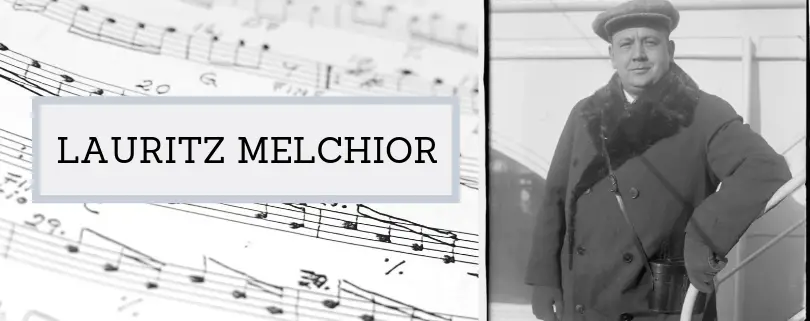Lauritz Melchior, Tenor – the opera guide
The online opera guide to Lauritz Melchior
Read the short biography of Lauritz Melchior and listen to highlights of his career. Lauritz Melchior is considered the “heroic tenor of the 20th century”. Lauritz Melchior had a voice with incredible vocal power coupled with the ability to sing subtly.
The ascent
Lauritz Melchior was born on 20 March 1890 in Copenhagen. He started his career as a baritone. He made his stage debut in Copenhagen in 1913. A meticulous planned conversion to the tenor Fach took place and he gave his debut in 1918 as Tannhäuser. His career made its first leap when he got a commitment for a performance at one of the first radio broadcasts as a partner with Nellie Melba. His career developed and he became a regular guest at the Bayreuth Festival in the 20’s. Cosima Wagner called him “the great Dane”. Melchior boycotted the festival from 1931 on because of their entanglements with the Nazis. He celebrated triumphal successes at the Met starting 1929, where he subsequently had the focus of his artistic activity.
His voice
Lauritz Melchior had a voice with incredible vocal power coupled with the ability to sing subtly. The baritone colored voice was dark timbred and brilliant at the same time (Kesting). Listen to an excerpt from the first act of the Valkyrie:
Winterstürme wichen dem Wonnemond – Melchior
His work
Melchior sang the great heroic tenor parts incredibly often. For example 223 times Tristan, 183 times Siegmund, 144 times Tannhäuser. This resulted in a total of over 1000 Wagner performances ! He also sang the Othello, Radames and the Canio several times. His most important partners were Frida Leider, Kirsten Flagstadt and Lotte Lehmann. Many of the resulting records are still reference recordings.
Liebesduett (Tristan) – Melchior / Flagstadt
During his career he had no competitor to fear in the Heldentenorfach, even though his acting skills stagnated towards the end of his career.
His stage farewell took place in 1950 with Lohengrin. Melchior also sang demanding roles excellently in his advanced age. For example he sang Siegfried and Othello at the age of 70, which are documented in recordings. He died in 1973 in Santa Monica.
Significance
Lauritz Melchior is considered the “heroic tenor of the 20th century”. To this day he has not found a successor. Cosima Wagner called him “the great Dane”.
Some highlights of his recordings
From the Holländer you hear «Mit Gewitter und Sturm»
Mit Gewitter und Sturm
Melchior was a fantastic Siegmund (Die Walküre). Here with his congenial partner Lotte Lehmann.
Wes Herd dies auch sei – Lehmann / Melchior/ Walter
«Never before has there been such a powerful tenor voice, with a dark timbre and at the same time so brilliant, and to this day he has found no successor» (Scott). Listen to Lauritz Melchior in the sword-scene :
Deines Auges Glut…Nothung – Melchior / Lehmann
There is one singer who outshines all other tenors in the male leading role of Siegmund: Lauritz Melchior (1899-1973). If you have never heard him before, get an acoustic impression of his voice with the piece «Wälse», a document famous in recording history where he sings Wälse calls more often with 15 or more seconds of sound duration! According to many experts, «Never before has there been such a powerful tenor voice, with a dark timbre and at the same time so brilliant, and to this day he has found no successor» (Scott).
Wääääääääälse! – Melchior
The dreamlike «Winterstürme wichen dem Wonnemond».
Winterstürme wichen dem Wonnemond… Du bist der Lenz – Melchior / Walter / Lehmann
We hear a recording from 1940 from Lohengrin. Melchior’s vocal reserves seem inexhaustible and his diction is excellent, probably dating back to his Bayreuth days, when he rehearsed the role with Cosima Wagner.
In fernem Land
The next interpretation is from Verdi’s Otello in a German-language recording. Especially remarkable is his impressive crescendo from pianissimo to fortissimo of “quel raggio”.
Dio mit potevi scagliar tutti i mali
Lauritz Melchior has sung Tannhäuser 144 times on stage. His voice was that of a heroic tenor who could also sing lyrically and colourfully, which made him a great Wagner tenor.
Dir töne Lob
Lauritz Melchior was possibly the greatest Wagner tenor of all time. The “great Dane”, as Cosima called him, was an elemental force. He claimed of himself that he could easily sing Tristan 2 times in the evening. He was a master of expression with pathos, so his Roman Tale (from Tannhäuser) at the end of a very challenging opera was masterful.
Inbrunst im Herzen
The true drama of this work by Shakespeare takes place inside the characters. Otello must bring all shades of personality to life. Verdi requires Otello to constantly alternate between recitative, declamation and cantabile singing. The tenor’s score is strewn with constantly changing expression marks (piano, morendo, dolce, con espressione, etc.). “Dio mi potevi scagliar” starts in the pale tone of despair, goes on to a middle section in piano and ends in the fortissimo of “Ah dannazione”.
We hear Lauritz Melchior in a German-language recording. Especially remarkable is his impressive crescendo from pianissimo to fortissimo of “quel raggio”.
Dio mit potevi scagliar tutti i mali
Lohengrins Erzählung ist in einem feierlichen, gemessenem Tempo komponiert. Die Stimme muss würdevoll, doch leicht, glänzend und mysteriös sein, fern vom pathetisch-heroischen. Mit feierlicher Stimme besingt er das alljährliche Wunder «Alljährlich naht vom Himmel eine Taube um neu zu stärken seine Wunderkraft. Es heisst der Gral». Ein wunderschönes weiches forte in A glänzt über dem schwirrenden Klang der Violinen. Die hohe Tessitura der folgenden Passage hält die Dramatik und Feierlichkeit hoch. Es ist für den Tenor eine anspruchsvolle Stelle, er muss die Stimm-Kraft hochhalten ohne die Stimme überanzustrengen. Zum Schluss enthüllt Lohengrin seinen Namen. Jetzt wechselt die Stimme, sie wird prächtig, ruhmreich und heroisch, keineswegs hohl, sondern edel. Es ist der Höhepunkt und Schlüssel der Oper. Ähnlich dem Tannhäuser mit der Rom Erzählung des letzten Aktes muss der Tenor seinen wichtigsten Abschnitt am Schluss singen. Das heisst, der Sänger muss am Schluss über genügend stimmliche Kraftreserve verfügen, um diesen Abschnitt zu einem Höhepunkt des Abends zu bringen. In Lohengrin ist die Aufgabe „einfacher“ denn die die Gralserzählung („In fernem Land“) und der Abschied („Mein lieber Schwan“) sind lyrische Stücke die beinahe Belcanto Charakter aufweisen, währenddem die Rom-Erzählung eine dramatische Stimme erfordert. In strahlenden A-Dur erzählt Lohengrin von seiner Herkunft. Es ist eine helle, hohe Tonart, die von den himmlischen Sphären des Grals kündet. Hohe flirrende Geigen vermitteln das Gefühl der Entrücktheit und des sphärischen.Der Däne Lauritz Melchior war vielleicht der größte Wagner Tenor der Geschichte. Seine Stimmreserven scheinen unerschöpflich und seine Diktion ist hervorragend, wahrscheinlich zürückgehend aus seiner Bayreuther Zeiten, wo er noch mit Cosima Wagner die Rolle einstudierte.
In fernem Land
Wir hören ihn einer Szene aus Wagners “Siegfried”. Er singt diesen für den Tenor so anspruchsvollen Akt mit einer grossartigen Intensität und Stimmkraft. Er hatte den neckischen Spitznamen «das wandelnde Sofa», er war nicht der geborene Schauspieler. Cosima Wagner schätzte ihn hoch und nannte ihn «den grossen Dänen». Er war wohl der glanzvollste Siegfried der Aufnahmegeschichte.
Nothung! Nothung! Neidliches Schwert – Melchior
Wie Mime hämmert Siegfried im Rhythmus des Nibelungen Motivs das Schwert. Triumphierend singen die beiden in einem Duett, deren Stimmen, für Wagner späteren Stil untypisch, sich zum Schluss triumphierend vereinigen.
Hoho! Hohei! Hahei! – Melchior / Reiss
Peter Lutz, the online opera guide




Leave a Reply
Want to join the discussion?Feel free to contribute!